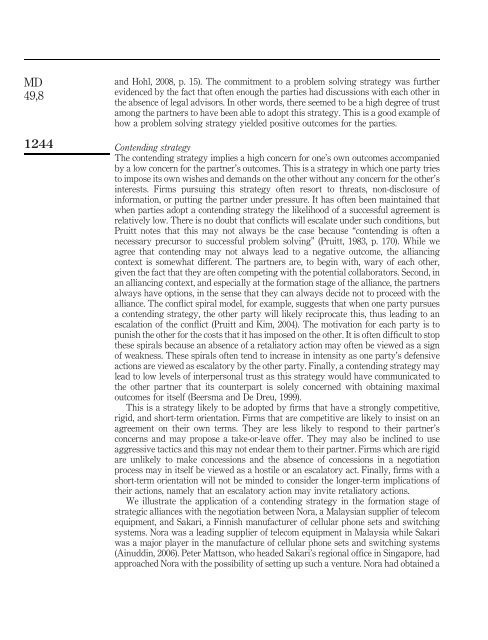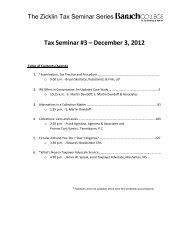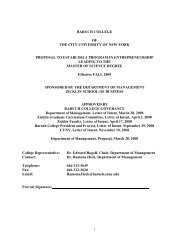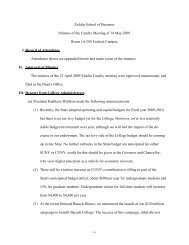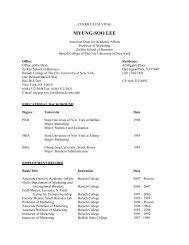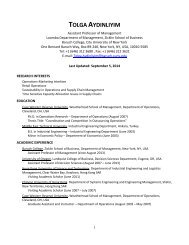alliances a strategic framework
Download - zicklin : school of business - CUNY
Download - zicklin : school of business - CUNY
- No tags were found...
You also want an ePaper? Increase the reach of your titles
YUMPU automatically turns print PDFs into web optimized ePapers that Google loves.
MD<br />
49,8<br />
1244<br />
and Hohl, 2008, p. 15). The commitment to a problem solving strategy was further<br />
evidenced by the fact that often enough the parties had discussions with each other in<br />
the absence of legal advisors. In other words, there seemed to be a high degree of trust<br />
among the partners to have been able to adopt this strategy. This is a good example of<br />
how a problem solving strategy yielded positive outcomes for the parties.<br />
Contending strategy<br />
The contending strategy implies a high concern for one’s own outcomes accompanied<br />
by a low concern for the partner’s outcomes. This is a strategy in which one party tries<br />
to impose its own wishes and demands on the other without any concern for the other’s<br />
interests. Firms pursuing this strategy often resort to threats, non-disclosure of<br />
information, or putting the partner under pressure. It has often been maintained that<br />
when parties adopt a contending strategy the likelihood of a successful agreement is<br />
relatively low. There is no doubt that conflicts will escalate under such conditions, but<br />
Pruitt notes that this may not always be the case because “contending is often a<br />
necessary precursor to successful problem solving” (Pruitt, 1983, p. 170). While we<br />
agree that contending may not always lead to a negative outcome, the alliancing<br />
context is somewhat different. The partners are, to begin with, wary of each other,<br />
given the fact that they are often competing with the potential collaborators. Second, in<br />
an alliancing context, and especially at the formation stage of the alliance, the partners<br />
always have options, in the sense that they can always decide not to proceed with the<br />
alliance. The conflict spiral model, for example, suggests that when one party pursues<br />
a contending strategy, the other party will likely reciprocate this, thus leading to an<br />
escalation of the conflict (Pruitt and Kim, 2004). The motivation for each party is to<br />
punish the other for the costs that it has imposed on the other. It is often difficult to stop<br />
these spirals because an absence of a retaliatory action may often be viewed as a sign<br />
of weakness. These spirals often tend to increase in intensity as one party’s defensive<br />
actions are viewed as escalatory by the other party. Finally, a contending strategy may<br />
lead to low levels of interpersonal trust as this strategy would have communicated to<br />
the other partner that its counterpart is solely concerned with obtaining maximal<br />
outcomes for itself (Beersma and De Dreu, 1999).<br />
This is a strategy likely to be adopted by firms that have a strongly competitive,<br />
rigid, and short-term orientation. Firms that are competitive are likely to insist on an<br />
agreement on their own terms. They are less likely to respond to their partner’s<br />
concerns and may propose a take-or-leave offer. They may also be inclined to use<br />
aggressive tactics and this may not endear them to their partner. Firms which are rigid<br />
are unlikely to make concessions and the absence of concessions in a negotiation<br />
process may in itself be viewed as a hostile or an escalatory act. Finally, firms with a<br />
short-term orientation will not be minded to consider the longer-term implications of<br />
their actions, namely that an escalatory action may invite retaliatory actions.<br />
We illustrate the application of a contending strategy in the formation stage of<br />
<strong>strategic</strong> <strong>alliances</strong> with the negotiation between Nora, a Malaysian supplier of telecom<br />
equipment, and Sakari, a Finnish manufacturer of cellular phone sets and switching<br />
systems. Nora was a leading supplier of telecom equipment in Malaysia while Sakari<br />
was a major player in the manufacture of cellular phone sets and switching systems<br />
(Ainuddin, 2006). Peter Mattson, who headed Sakari’s regional office in Singapore, had<br />
approached Nora with the possibility of setting up such a venture. Nora had obtained a


